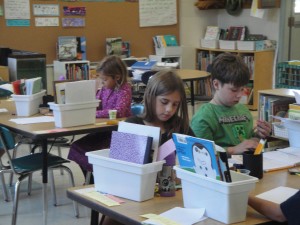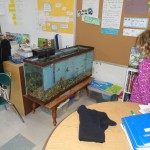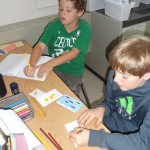 It has been an interesting week. While we have done quite a bit, it also feels as though little has been accomplished. It was a challenging week to get momentum going. Here is a quick list of thing you might want to ask your child about –
It has been an interesting week. While we have done quite a bit, it also feels as though little has been accomplished. It was a challenging week to get momentum going. Here is a quick list of thing you might want to ask your child about –
One third of our NECAP testing has been completed and that is a grand accomplishment. The children deserve to feel proud of their effort. General comments have been that the test was hard and long, but also different and sort of fun.
We began discussing leads and the choices authors make so they can “hook” their readers right from the start. Some books begin with questions, others begin with general overviews and still others begin by appealing to a reader’s senses to create strong mental images. We are looking at the books we read and trying to imitate the craft choices we see in our own narrative writing.
We learned about affixes. Prefixes are the letters added to the beginnings of words. Suffixes are added at the end of words. These letter groups change the meaning of the base words in small ways. Open can become reopen, and reopen can become reopens, reopened or reopening.
We explored compound words – two words that are put together to make a totally new and different word. You can have a cup and you can have a cake; put them together and you have a cupcake. We are in the process of making some compound word riddles based on the book Punnidles by Bruce McMillan.
Our numbers of the week this week have to do with the three chapter read-alouds we’ve completed since the beginning of the school year. See if your child can remember the number of chapters we’ve read together so far and the number of pages we’ve completed this year. We’re off to a great reading-together start.
We completed Emily and Jackson – Hiding Out by Phyllis Naylor Reynolds. Ask your child what his or her favorite part of the story has been or a part s/he thought was exciting. Was it the tornado? Was it when Uncle Victor kidnapped Emily? Was it when Spook came to the rescue? Each of the chapters in the two “Emily” books ends with a funny question like, “Now what in the wimpy waffles will she do?” The class has fun wondering where the question will lead. I can see that idea creeping into some of the students’ own writing and hear it throughout the day in different conversations. It’s fun.
We are learning more about science. We have planted seeds and set up a barometer so we’ll be able to observe changes over time. We haven’t seen any changes yet, but we keep looking. We have identified the different parts of the scientific method: question, hypothesis or prediction, materials and procedure, leading to the outcome or conclusion. Are we explored different processes we realize that often one conclusion leads to a new question. It could be an endless cycle of wondering.
We are considering how science is important in our world. Next week the children will begin a small science/craft project at home called “Scientist in a Bag”. Your child will learn about one type of scientist and teach what they learn to the rest of the class. In school they will draw a scientist (like entomologist or pathologist) to become an expert on. At home they will need help to learn what that scientist does, what tools that type of scientist uses and how the work of that scientist helps our world. Be on the lookout for more information in next week’s homework.















